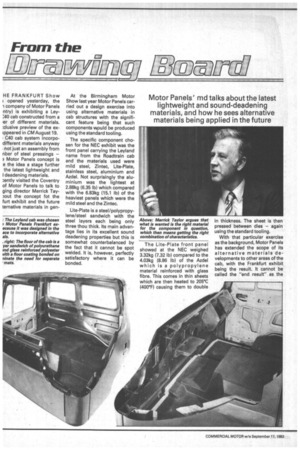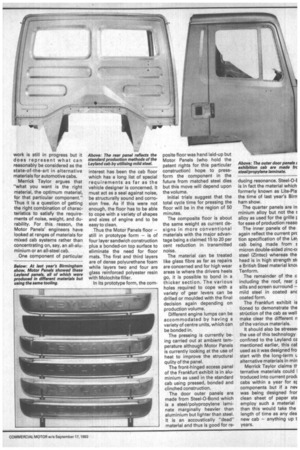From the
Page 42

Page 43

If you've noticed an error in this article please click here to report it so we can fix it.
ratrmyyrdupo
Motor Panels' md talks about the latest lightweight and sound-deadening materials, and how he sees alternative materials being applied in the future
HE FRANKFURT Show
opened yesterday, the company of Motor Panels ntry) is exhibiting a Ley:40 cab constructed from a ,er of different materials. :clusive preview of the exippeared in CM August 19. C40 cab system incorpodifferent materials anyway not just an assembly from nber of steel pressings — ?. Motor Panels concept is e the idea a stage further the latest lightweight and i deadening materials.
-.:ently visited the Coventry of Motor Panels to talk to ging director Merrick Tay)out the concept fot the furt exhibit and the future ternative materials in gen
At the Birmingham Motor Show last year Motor Panels carried out a design exercise into using alternative materials in cab structures with the significant feature being that such components would be produced using the standard tooling.
The specific component chosen for the NEC exhibit was the front panel carrying the Leyland name from the Roadtrain cab and the materials used were mild steel, Zinted, Lite-Plate, staintess steel, aluminium and Azdel. Not surprisingly the aluminium was the lightest at 2.88kg (6.35 lb) which compared with the 6.83kg (15.1 lb) of the heaviest panels which were the mild steel and the Zintec.
Lite-Plate is a steel/polypropylene/steel sandwich with the steel layers each being only three thou thick. Its main advantage lies in its excellent sound deadening properties but this is somewhat counterbalanced by the fact that it cannot be spot welded. It is, however, perfectly satisfactory where it can be bonded. The Lite-Plate front panel showed at the NEC weighed 3.32kg (7.32 lb) compared to the 4.03kg (8.86 lb) of the Azdel which is a polypropylene material reinforced with glass fibre. This comes in thin sheets which are then heated to 205°C (400°F) causing them to double in thickness. The sheet is then pressed between dies — again using the standard tooling.
With that particular exercise as the background, Motor Panels has extended the scope of its alternative materials developments to other areas of the cab, with the Frankfurt exhibit being the result. It cannot be called the "end result" as the work is still in progress but it does represent what can reasonably be considered as the state-of-the-art in alternative materials for automotive cabs.
Merrick Taylor argues that "what you want is the right material, the optimum material, for that particular component." Thus it is a question of getting the right combination of characteristics to satisfy the requirements of noise, weight, and durability. For this reason, the Motor Panels' engineers have looked at ranges of materials for mixed cab systems rather than concentrating on, say, an all-aluminium or an all-steel cab.
One component of particular interest has been the cab floor which has a long list of special requirements as far as the vehicle designer is concerned. It must act as a seal against noise, be structurally sound and corrosion free. As if this were not enough, the floor has to be able to cope with a variety of shapes and sizes of engine and to be easy to clean.
Thus the Motor Panels floor — still in prototype form — is of four layer sandwich construction plus a bonded-on top surface to eliminate the need for floor mats. The first and third layers are of dense polyurethane foam while layers two and four are glass reinforced polyester resin with Molochite filler.
In its prototype form, the corn
posite floor was hand laid-up but Motor Panels who hold the patent rights for this particular construction) hope to pressform the component in the future from matched steel dies but this move will depend upon the volume.
Initial trials suggest that the total cycle time for pressing the floor will be in the region of 50 minutes.
The composite floor is about the same weight as current designs in more conventional materials with the major advantage being a claimed 15 to 20 per cent reduction in transmitted noise.
The material can be treated like glass fibre as far as repairs are concerned and for high wear areas le where the drivers heels go, it is possible to bond in a thicker section. The various holes required to cope with a variety of gear levers can be drilled or moulded with the final decision again depending on production volume.
Different engine lumps can be accommodated by having a variety of centre units, which can be bonded in.
The pressing is currently being carried out at ambient temperature although Motor Panels is currently looking at the use of heat to improve the structural qulity of the panel.
The front-hinged access panel of the Frankfurt exhibit is in aluminium as used in the standard cab using pressed, bonded and clinched construction.
The door outer panels are made from Steel-O-Bond which is a steel/polypropylene laminate marginally heavier than aluminium but lighter than steel. It is an accoustically "dead" material and thus is good for re ducing resonance. Steel-O-E is in fact the material which formerly known as Lite-Pla the time of last year's Sim' ham show.
The quarter panels are in minium alloy but not the alloy as used for the grille r for ease of production reaso The inner panels of the again reflect the current prc tion specification of the Le) cab being made from F. micron double-sided zinc-ct steel (Zintec) whereas the head is in high strength sti a British Steel material knot Tenform.
The remainder of the c including the roof, rear r sills and screen surround — mild steel in coated anc coated form.
The Frankfurt exhibit is tioned to demonstrate the strktion of the cab as well make clear the different n of the various materials.
It should also be stresse4 the use of this technology confined to the Leyland ca mentioned earlier, this cat used as it was designed fro start with the long-term u alternative materials in min Merrick Taylor claims th ternative materials could I troduced into current prock cabs within a year for sr components but if a nev was being designed fror clean sheet of paper sta employ such a meterial than this would take the length of time as any des new cab — anything up t years.
































































































